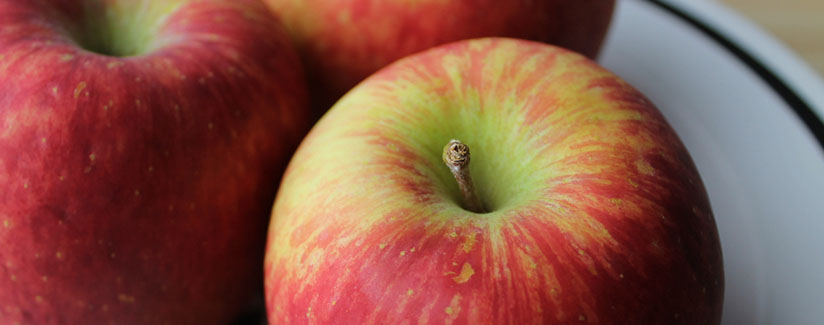
Developers Hope New Fruit Becomes the Apple of Consumers’ Eye
02/13/2015
Does an apple that doesn’t turn brown after taking a bite sound appealing? Such an apple has been developed with the help of biotechnology by Okanagan Specialty Fruits (OSF) of British Columbia, Canada. After a lengthy government process, they have now been approved in the United States, though it will still be a few years before they’re available in stores. We spoke about this new fruit, called the Arctic® apple, with Neal Carter, OSF’s president and founder, and also reached out to Dr. Herbert Aldwinckle, professor emeritus at Cornell University’s Department of Plant Pathology and Plant Microbe Biology, for some insight.
What factors drove the development of a non-browning variety of apple?
Carter:
Apple consumption has been flat-to-declining for the past couple decades, while obesity rates have been increasing. Consumers are demanding more convenience than ever and browning is the number one barrier to apples meeting the demand as a more “snackable” food.
We know the demand is there, as evidenced by findings such as the Produce Marketing Association determining that apples are consumers’ most requested packaged produce item. Non-browning apples open the door to higher-quality, lower-cost fresh-cut apple products because they reduce the need for anti-browning solutions, which can add up to 40% in processing costs and may affect taste. Additionally, a recent study from Cornell University found that children eat around 70% more apples when they’re served pre-sliced.
So, we know that Arctic® apples can boost consumption by offering new product opportunities, opening new markets, reducing costs, improving quality and boosting convenience. Additionally, apples are one of the most wasted foods on the planet, and much of that waste is due to superficial bruising/browning throughout the supply chain. Another key reason we decided to make non-browning apples our flagship project over other possibilities is because the stigma attached to them being a biotech product is largely balanced by the fact that Arctic apples are one of the only biotech foods with a direct consumer benefit.
In fact, the fact that most biotech crops haven’t offered consumer benefits to date is perhaps the main reason a stigma exists in the first place.
What kinds of things take place during the approval process?
Carter:
It has been a long and rigorous process! In the mid-90s, we became aware of work being done in Australia to develop potatoes that had reduced levels of polyphenol oxidase, the enzyme that causes browning in many fruits and vegetables. We knew this would provide benefits for the apple industry and spent a number of years determining the best way to apply this technology to apples.
Once we were able to successfully prove the science in 2002, we received approval from the U.S. Department of Agriculture (USDA) to plant field trials in 2003 (after a great deal of paperwork and satisfying a number of requirements). We then had these trials closely monitored, primarily by independent horticultural specialists who collected a great deal of data. A wide range of testing and analysis on both the orchard and the fruit itself was performed to satisfy USDA’s Animal and Plant Health Inspection Service (APHIS) requirements, such as environmental impact evaluation (cross-pollination studies, ensuring no plant pest risks exist, etc.) compositional analysis, testing for novel proteins, and much more.
After sufficient information was collected, we submitted a petition requesting deregulation (commercial approval) to the USDA in 2010. After extensive data review and two additional public comment periods, the process is complete and the Arctic apple can now be made available to the U.S. public. That said, it takes a number of years for newly-planted trees to produce significant quantities of fruit. So, we expect to have small quantities available for test markets in fall 2016, with an increasing amount of fruit available each consecutive year.
Will consumers be able to tell the difference in taste and texture? Will they be more expensive than regular apples?
Carter:
For the first bite of a perfect, undamaged piece of fruit, an Arctic® Granny’s taste and texture would be indistinguishable from a conventional Granny Smith. The same goes for an Arctic® Golden vs. a conventional Golden Delicious or any other Arctic variety compared to its conventional counterpart. But, that changes if both had been already bitten, sliced or bruised, because Arctic apples better retain their positive sensory characteristics.
While OSF will not have control over retail pricing, Arctic apple varieties will likely be comparable in price to their conventional counterparts, thus offering a better value to the consumer.
Are there benefits to the Arctic® apple besides the fact it won’t turn brown?
Carter:
In addition to the improved visual and mouth appeal in sliced apples, nutrients like vitamin C, antioxidants and phenolic content that is typically “burned up” in the browning reaction are better retained in Arctic fruit. As previously mentioned, Arctic apples also avoid the need for costly anti-browning treatments that can create an “off-taste”, and in some circumstances create allergy concerns such as sulfite use in dried apple products.
For whole apples, superficial bruises will not result in unsightly brown marks, which offers a number of benefits. Many apples are thrown out or downgraded because of superficial damage from when they are picked until they are eaten. Arctic apples can greatly reduce this waste.
Another great example of a benefit the average consumer would never consider or be aware of is that lighter-skinned varieties such as Golden Delicious are typically warmed up prior to packing. This is done to make them softer so they’re less prone to packing-line damage. However, this costs time and money, and also permanently reduces the crispness of these apples. Arctic Goldens would not need to undergo this process – benefitting both packers and consumers.
Additionally, if there is meaningful damage on a piece of fruit, such as from bacterial or fungal infection, Arctic apples will still show discoloration. This makes it easier for consumers to judge the true quality of the fruit.
Aldwinckle:
I think the new technology will increase consumption of apples, especially by kids who would otherwise not eat them once they turned brown despite being perfectly healthy and nutritious. The ability to have pre-packaged apple slices in the produce section that don’t brown will be a great convenience for parents looking for a nutritous snack for their children’s lunch boxes. Nutrition will likely improve as a result, because apples contain many nutrients that are known to help keep us healthy.
Is there a way for consumers to tell they are genetically modified?
Carter:
We plan to work with marketers of Arctic apples to assure that consumers who buy apples can identify Arctic apples at the retail shelf, as well as provide a mechanism by which they can learn more about Arctic apples at point of sale.
Do you think consumers are ready for a genetically modified apple?
Aldwinckle:
I can appreciate consumer concerns, and my hunch is that they’re worried because the technology is new to them. A non-browning apple sounds unusual, and we’ve gotten used to apples turning brown. I can tell you, however, that this technology is very safe. We’re not introducing any new genes to stop the browning effect – we’re actually silencing the genes that cause the browning. It’s a very gentle technology, and I’ve found no danger to the healthfulness of the fruit.
Carter:
Absolutely! We’ve done a great deal of consumer research over the past few years, including focus groups, online surveys, taste tests and more. Our findings consistently demonstrate that the vast majority of consumers are interested in non-browning Arctic apples. And, while we know that some consumers are initially unsupportive because Arctic apples are produced with biotechnology, once they learn more about the science behind them, most consumers’ likelihood to purchase increases to an even higher level than before they knew they were genetically engineered.
“Camera Test Apple” by Kirinohana is licensed under CC BY.


























